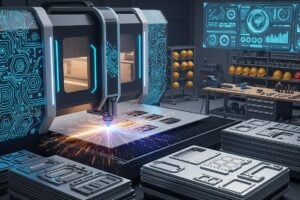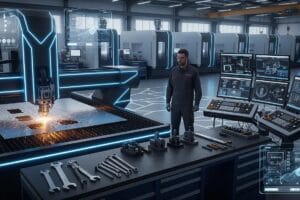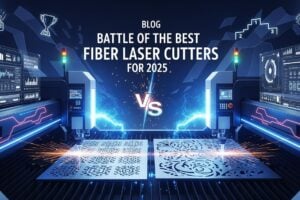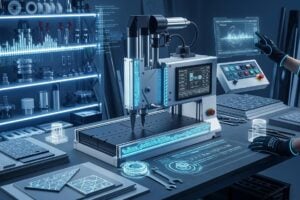Fiber Laser Cutting Machine is a device that uses the high energy density of laser beams to cut materials. It focuses the laser into an extremely fine high-energy beam through an optical system and irradiates the workpiece surface, causing the material to melt, vaporize or reach the ignition point instantly. At the same time, it uses a high-speed airflow coaxial with the beam to blow away the molten material, thereby achieving cutting.
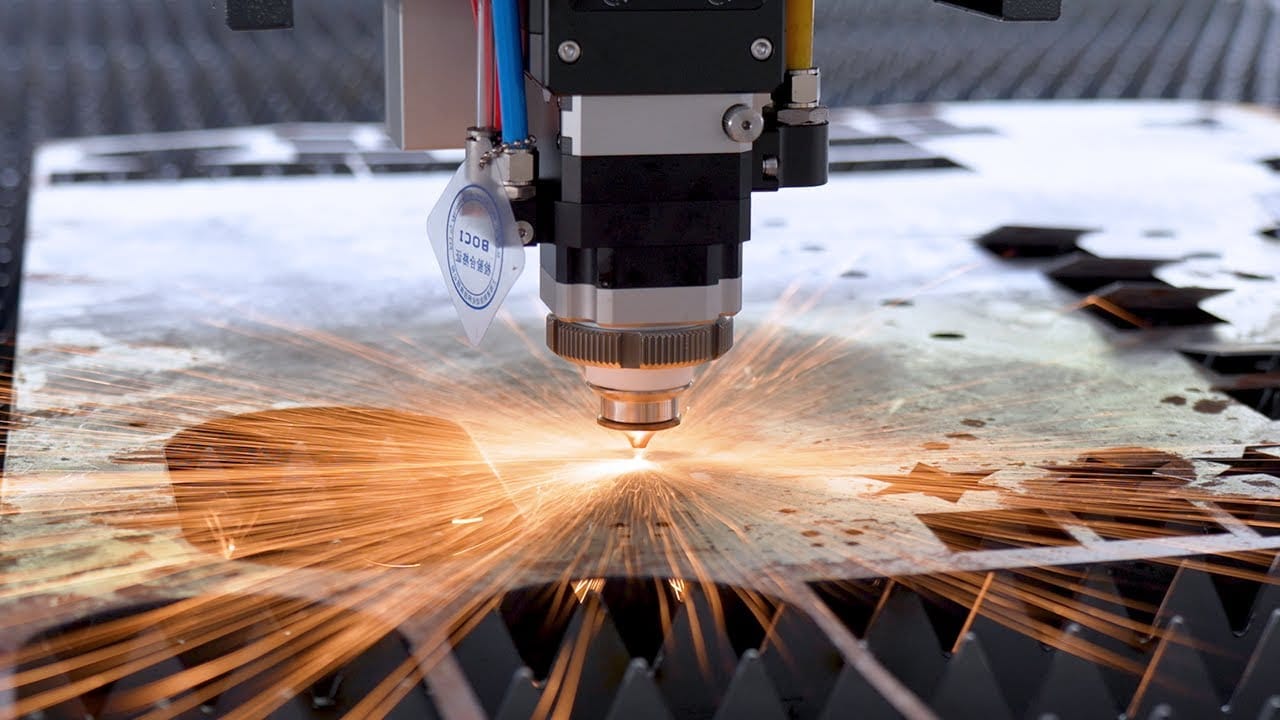

Table of Contents
1.How does Fiber Laser Cutting Machine work?
Fiber Laser Cutting Machine is a laser processing machine tool mainly used to cut plates into workpieces of desired shapes. It is a device that uses the heat energy of the laser beam to achieve cutting.
Laser cutting is to use the energy released when the laser beam is irradiated onto the surface of the workpiece to melt and evaporate the workpiece to achieve the purpose of cutting and engraving. It has the characteristics of high precision, fast cutting, no restrictions on cutting patterns, automatic typesetting to save materials, smooth incisions, and low processing costs. It will gradually improve or replace traditional cutting process equipment.
The original Chinese name of laser is “laser”, which is the transliteration of its English name LASER. It is an abbreviation composed of the first letters of each word in the English word Light Amplification by Stimulated Emission of Radiation. It means “light amplification by stimulated emission of radiation”. What is “stimulated emission of radiation”? It is based on a new set of theories proposed by the great scientist Einstein in 1916. This theory says that in the atoms that make up matter, there are different numbers of particles (electrons) distributed at different energy levels. When particles at high energy levels are stimulated by certain photons, they will jump (transition) from high energy levels to low energy levels. At this time, they will radiate light of the same nature as the light that stimulates it, and under certain conditions, a weak light can stimulate a strong light. This is called “light amplification by stimulated emission of radiation”, or laser for short. Lasers have four main characteristics: high brightness, high directionality, high monochromaticity and high coherence.
High brightness of lasers: The brightness of solid lasers can be as high as 1011W/cm2Sr. Moreover, after being focused by a lens, a high-brightness laser beam can generate a high temperature of thousands or even tens of thousands of degrees near the focal point, which makes it possible to process almost all materials.
High directivity of laser: The high directivity of laser enables it to effectively transmit over a long distance while ensuring that it can focus on a very high power density. Both of these are important conditions for laser processing.
High monochromaticity of laser: Due to the extremely high monochromaticity of laser, it ensures that the beam can be accurately focused on the focal point and obtain a very high power density.
High coherence of laser: Coherence mainly describes the phase relationship between the various parts of the light wave. It is precisely because of the singular characteristics of laser as described above that it has been widely used in industrial processing.
Lasers have been widely used in laser welding, laser cutting, laser drilling (including oblique holes, different holes, plaster drilling, cork paper drilling, steel plate drilling, packaging and printing drilling, etc.), laser quenching, laser heat treatment, laser marking, glass engraving, laser fine-tuning, laser lithography, laser film making, laser thin film processing, laser packaging, laser repair circuits, laser wiring technology, laser cleaning, etc.
2.What are the key components of Fiber Laser Cutting Machine?
Fiber Laser Cutting Machine realizes the whole process from energy generation to precise cutting through the coordinated work of five systems: “laser generation – optical transmission – mechanical movement – intelligent control – auxiliary gas”. Under different materials and precision requirements, the configuration of the equipment (such as laser power, control system accuracy, auxiliary gas type) will be different, and the bed structure and safety system are the basis for ensuring the stable operation of the equipment.
2.1Laser transmitter: According to different working principles, it can be divided into CO2 laser (suitable for non-metallic and some metal materials), fiber laser (high metal cutting efficiency), YAG laser (mainly pulse cutting), etc. The power of the laser determines the cutting thickness and speed. For example, the power of fiber laser is commonly 1000W to 20000W. 2.2 Servo motor: Receives control system instructions, drives the guide rail to achieve high-speed, precise positioning and interpolation movement (such as servo motor speed can reach thousands of revolutions per minute), transmits motor power to each axis through gears, racks or synchronous belts to ensure smooth movement.
2.3 Chiller: The laser generates a lot of heat when working, and needs to be cooled by water cooling or air cooling to avoid overheating and damage to the equipment (such as water chillers take away heat through circulating pure water).
2.4 Controller: Coordinates the work of various systems and executes the cutting program. It is the “brain” of the equipment. Commonly used systems such as Beckhoff, Haibao, and domestic Baichu support the import of CAD/CAM drawings, generate cutting paths, and control motor movement and laser output. Human-computer interaction interface, used to input parameters (such as power, speed, gas pressure) and monitor operating status. Including position sensors (detecting cutting head coordinates), temperature sensors (monitoring equipment status), collision sensors (preventing cutting head from colliding with materials), etc., to ensure safe operation of the equipment.
2.5 Auxiliary gas: Select the gas type according to the material, such as oxygen (combustion support, used for carbon steel cutting), nitrogen (protection, used for stainless steel/aluminum alloy), compressed air (low cost, suitable for thin materials).
3.What are the types of Fiber Laser Cutting Machine?
3.1 Fiber Laser Cutting Machine: It uses fiber laser and rare earth doped fiber as gain medium, with photoelectric conversion efficiency of more than 30% (traditional CO₂ laser is only about 10%). The wavelength is 1.06μm, with high absorption rate for metal materials (especially carbon steel, stainless steel, aluminum alloy), and fast cutting speed (such as 1mm carbon steel cutting speed can reach more than 10m/min).
3.2 CO₂ Fiber Laser Cutting Machine: The laser uses CO₂ gas as working medium, with a wavelength of 10.6μm, and has high absorption rate for non-metallic materials (such as acrylic, wood, cloth), but the metal cutting efficiency is lower than that of fiber laser. The power range is wide (500W-20000W), and high-power models can cut thick metals (such as carbon steel over 20mm), but the energy consumption is higher.
3.3 YAG Fiber Laser Cutting Machine: It uses solid YAG (yttrium aluminum garnet) laser with a wavelength of 1.06μm, mostly works in pulse mode (high peak power), and has low continuous power (usually ≤2000W). It can transmit laser through optical fiber, has high flexibility, but has low photoelectric conversion efficiency (about 3%-5%), and requires a water cooling system.
3.4 Comparison table of different types of Fiber Laser Cutting Machine
| Classification Dimension | Representative Type | Core Advantages | Typical Applications |
| Laser Type | Fiber laser cutting machine | High power, high efficiency, low maintenance | High-speed cutting of thin and medium metal plates |
| CO₂Laser Cutting Machine | Strong adaptability to non-metals, thick metal cutting | Acrylic, wood, 20mm carbon steel | |
| Mechanical structure | Gantry type | Large size, high stability | Engineering machinery plates |
| Three-dimensional five-axis | Curved surface processing, complex shapes | Automobile body parts | |
| Applied Materials | Special for metal | High power metal cutting | Automobile accessories, steel structures |
| Special for non-metal | Smooth edges, no thermal damage | Clothing cutting, advertising logos | |
| Power level | High power (≥10000W) | Fast cutting speed for thick materials | Cutting of carbon steel above 20mm |
There are various types of Fiber Laser Cutting Machines. When choosing one, you need to consider the material type (metal/non-metal), thickness, processing accuracy, production efficiency and cost budget. For example, fiber laser cutting machines are preferred for metal processing, CO2 machines are preferred for non-metal processing, and ultrafast lasers or three-dimensional equipment are required for precision parts. With the development of technology, high-power, intelligent, and multi-functional integration (such as integrated cutting of pipes and plates) has become the mainstream trend.
4.How to Operate CNC Fiber Laser Cutting Machine?
4.1. Normal startup and shutdown process
Startup steps: First start the voltage stabilizer, then turn on the water cooling, air compressor, cold dryer, CNC, laser and nitrogen cylinder (pressure control valve is about 0.5MKA), and finally open the operation panel. At the beginning of startup, it is necessary to perform zero return operation to ensure that the emergency stop has been released and the alarm has been cleared, and then start zero return. If an alarm occurs during the zero return process, it is necessary to reset the alarm first and then continue zero return. If zero return is not possible or the zero return is not completed and stops, enter SIEMENS→Start up→NCK Reset→YES to restart the CNC system, wait for all the red lights on the handheld device to light up, press SETZERO to return to zero, or shut down the main control computer and restart it to return to zero. Standby operation: If the equipment needs to be temporarily disabled, it can be placed in standby mode, turn off HV ON and press the emergency stop switch. Shutdown process: First reduce the high voltage, turn off the laser, then turn off the operation panel, water cooling machine, cold dryer, etc., and finally turn off all gas cylinders. In addition, the air compressor and cold dryer need to be drained every day. If the equipment runs 24 hours a day, the water should be drained at least once every 6 hours. In summer, when the air is humid, the water should be drained once every 4 hours.
4.2. Skilled in machine tool operation and cutting process
Before production, the program needs to be copied into the equipment, and the corresponding cutting parameters need to be adjusted according to the material and thickness. Select a suitable nozzle, perform center alignment and focus adjustment, and start cutting after confirming that the program is correct and the gas is turned on. Please note that center alignment requires repeated practice to master the feel so that the light can be quickly aligned.
For the selection of nozzles, 1.0 nozzles can be used for cutting carbon steel below 6MM, 1.5 nozzles for 8MM and 12MM carbon steels, and 2.0 nozzles are suitable for carbon steel above 14MM. For stainless steel, 2.0 nozzles can be used for materials below 4MM, and 2.5 nozzles for materials above 5MM. It is recommended to use double-layer nozzles when cutting carbon steel, while single-layer nozzles are used for stainless steel.
In terms of cutting gas, the oxygen pressure needs to be controlled by CNC, but the outlet pressure on the pressure reducing valve side must not exceed 0.5MPA (otherwise the electronic valve cannot be opened). The nitrogen gas pressure should be controlled within 25 kg.
4.3. Selection and adjustment of perforation gas
When cutting stainless steel or carbon steel, the selection of perforation gas is crucial. For stainless steel below 3 mm, nitrogen is recommended for perforation. When cutting stainless steel or carbon steel above 4 mm, oxygen should be used.
After perforation, the nitrogen pressure needs to be further adjusted for stainless steel cutting. Specifically, when cutting stainless steel below 2 mm, the nitrogen pressure should be controlled at 8 kg; when cutting 3 mm and 4 mm stainless steel, the nitrogen pressure needs to reach 10 kg; for 5 mm and 6 mm stainless steel, the nitrogen pressure is set to 12 kg; when cutting 8 mm stainless steel, the nitrogen pressure requirement is 15 kg.
If oxygen is used to cut stainless steel, the operation method is the same as cutting carbon steel, and no special adjustment is required.
In addition, it is necessary to ensure that the focus position has been accurately adjusted before cutting. It is recommended to find a piece of material of the same thickness for trial cutting to achieve the best state before cutting the product. At the same time, follow the principle of internal reverse and external smoothness to use tool compensation, and adjust the Kerf value in the parameters as needed. For the cutting of non-metallic materials, a mechanical sensor is required.
Laser ventilation is also an important part of daily maintenance. The laser needs to be gas-changed every 72 hours. When the GASCHANGE IN MAX24h alarm appears, the gas change operation should be performed immediately. When changing the gas, make sure that the LASERON is turned on and perform gas exchange in the order of F7→F6→F2→F7. Note that the laser can still be used for 24 hours after this alarm appears, but in order to ensure the beam quality, it is recommended to change the gas as soon as possible.
In addition, the use of the programming software SHAPE is also crucial. After drawing the graphics in CAD, it needs to be reset to zero and saved in .dxf format. After importing the CAD graphics, it is necessary to change the tool, add leads, restore the graphics, reorder, and finally save it as an n file to generate the program. If you need to further typeset or process a single graphic, you can perform the corresponding operations in the SHAPE software and then generate the program. Calculate line length: Import the graphics that need to calculate the line length into the software, save it as an e file, and you can know the cutting line length.
4.4. Maintenance and maintenance
The focusing lens needs to be cleaned regularly to keep it clean.
Check the external light path every month. If you find an offset, adjust it in time.
Clean the reflector every three months. If you find contamination on a daily basis, you should also clean it immediately.
Follow the operating manual and regularly maintain the machine tool, water cooler, and laser to ensure that the equipment is in the best condition.
For every two thousand hours of operation of the laser, the FARLEY LASERLAB after-sales service department will perform professional maintenance.
Maintenance and maintenance of the air compressor:
Check the oil level before starting the machine every day to ensure that it is at the 3/4 position. Wastewater needs to be discharged after shutdown.
Clean the heat dissipation net and air filter every week to keep them clean.
Clean the oil cooler and air cooler every 1000 hours to prevent blockage.
Check the belt tension every 1000 hours and adjust it in time.
Replace the air filter, oil filter and compressor oil every 4000 hours to ensure lubrication.
The temperature of the machine should not exceed 110 degrees when it is running, and the temperature should be maintained at 80-90 degrees during normal operation.
The number of motor starts should not exceed 20 times per hour to avoid excessive wear.
Do not use the emergency stop button in non-emergency situations to ensure safe operation.
The counterclockwise operation of the fan blade indicates that the line is not reversed, and the line connection needs to be checked.
Precautions for the cold dryer:
There should be a distance of more than 50 cm around the cold dryer to ensure good ventilation.
The indoor temperature should not exceed 35 degrees to avoid affecting the working efficiency of the cold dryer.
Sewage should be discharged every day to keep the cold dryer clean.
Clean the vents weekly and blow them with an air gun.
Clean the filter monthly and use a soft brush and soapy water to clean it.
4.5. Safety and protection
When using the cutting machine, especially in the oxygen area, smoking should be strictly prohibited to prevent safety hazards such as fire.
Safety regulations for laser operation:
Before starting the laser lighting, make sure that the personnel are away from the optical path to avoid potential safety risks.
When adjusting the external optical path, be careful to ensure that the light does not shine on the personnel, and pay attention to controlling the lighting power and time within a reasonable range.
After completing the external optical path adjustment, be sure to install all protective covers before cutting.
When replacing the gas, the high pressure must be removed first, and the mixed gas bottle and laser door must be closed immediately after the replacement. At the same time, do not open the laser electrical cabinet door at will to avoid touching the internal circuits and electronic components.
Precautions for switching the workbench:
It is recommended to avoid using the automatic switching function and ensure that the personnel are away from the workbench during the switching process.
When switching, please confirm that the cutting head has been raised, and pay close attention to the switching process. In case of emergency, stop immediately or take corresponding measures.
5.What are the advantages of Fiber Laser Cutting Machine?
CNC Fiber Laser Cutting Machine has shown significant advantages in the manufacturing industry due to its high precision, high efficiency and flexible processing characteristics. The following is an analysis from the dimensions of technical performance, processing capabilities, application scenarios, etc.:
5.1 High-precision cutting capability: After the laser beam is focused, the spot diameter can be as small as 0.05-0.1mm, the positioning accuracy is ±0.05mm, and the repeat positioning accuracy is ±0.02mm. It can realize the processing of complex graphics, tiny holes (diameter ≤0.5mm) and fine contours, especially suitable for high-precision demand scenarios such as electronic components and precision mechanical parts.
5.2 High-quality cutting surface: The heat affected zone (HAZ) of laser cutting is small (usually ≤0.1mm), the material deformation is low, the incision is flat and smooth, and in most cases, no secondary processing (such as grinding) is required, reducing post-processing procedures.
5.3 High-speed cutting and automation: The cutting speed increases significantly with power. For example, the speed of 2000W fiber laser cutting 1mm carbon steel can reach 20m/min, which is 3-5 times that of traditional plasma cutting; with the automatic typesetting function of the CNC system, the material utilization rate can be increased by 15%-30%. It supports 24-hour continuous operation, and realizes unmanned production through industrial robot loading and unloading or multi-station workbench, which is suitable for batch processing. The laser beam does not contact the material surface, avoiding the wear problem of traditional tools, no need to replace tools, and reducing downtime; at the same time, it does not produce mechanical stress, which is suitable for thin and brittle materials (such as ceramics and glass).
5.4: Wide material compatibility: It can cut carbon steel, stainless steel, aluminum alloy, copper, titanium alloy, etc., with a thickness range from 0.1mm thin plate to 25mm thick plate (different power equipment has significant differences, such as 10000W fiber laser can cut 20mm carbon steel).
5.5 Comprehensive cost reduction: Energy consumption: Fiber Laser Cutting Machine has an electro-optical conversion efficiency of 30%-40% (CO₂ laser is only 10%-15%), and has lower energy consumption at the same power; there is no tool loss, and the cost of consumables (such as auxiliary gas, lens) accounts for less than 5%. Labor cost, high degree of automation, one operator can monitor multiple devices at the same time, which saves more manpower than traditional punching machines that require multiple people to operate.
5.6 CNC Fiber Laser Cutting Machine has become the core equipment of modern manufacturing industry with “high precision, high efficiency and high flexibility”. Especially under the trend of intelligent manufacturing, its combination with industrial Internet and AI programming has further improved the level of intelligent processing, and is gradually replacing traditional extensive processing technology and becoming a standard tool for high-end manufacturing.
6.Limitations and Challenges of Fiber Laser Cutting Machine?
6.1 Limitations of material processing: Copper, aluminum and other metals: Due to their high reflectivity (copper’s reflectivity to 1064nm fiber laser exceeds 95%), laser energy is easily reflected, causing damage to the laser, and after melting, the viscosity is high and the fluidity is poor, and the cutting edge is prone to slag. For example, when cutting 2mm thick copper, a special high-power laser (≥6000W) is required and the speed is only 1/3 of carbon steel. For example, glass and acrylic (thickness > 5mm), lasers are easy to penetrate or scatter, and special coatings (such as blackening treatment) are required to achieve cutting.
6.2 Efficiency and quality bottlenecks of thick plate cutting: Thickness upper limit: Although high-power fiber lasers (10000W+) can cut 25mm carbon steel, the cutting speed drops sharply with increasing thickness (such as 10000W cutting 20mm carbon steel at a speed of about 1m/min), and the taper of the cut becomes larger (> 3°), and the heat-affected zone is significantly expanded (≥1mm), requiring secondary processing correction. When cutting thick carbon steel, oxygen is used to assist, and an oxide layer (thickness ≥ 0.2mm) is easily formed on the surface of the cut, affecting the quality of subsequent welding or coating. Chlorine/fluorine-containing materials: such as PVC and Teflon, will release toxic gases (such as chlorine) when cutting, requiring a special smoke exhaust system and explosion-proof equipment, and the laser is easily contaminated by decomposition products. High-hardness brittle materials: such as tungsten carbide and quartz glass, are prone to cracks due to thermal stress during cutting, and require water cooling or low-speed layered cutting.
6.3 Cost investment and high threshold: Equipment procurement cost is high: Low-power (1000W) fiber Fiber Laser Cutting Machine costs about 200,000-500,000 yuan, high-power (10000W) equipment can reach 3 million-8 million yuan, and five-axis linkage models exceed 10 million yuan, far exceeding traditional plasma cutting equipment (500,000-1 million yuan), and small and medium-sized enterprises are under great financial pressure. The operation and maintenance costs are significant. Energy consumption: 10,000W equipment consumes about 80-100 kWh of electricity per hour, and the annual electricity bill (based on a 2-shift system) exceeds 500,000 yuan; the auxiliary gas (nitrogen, oxygen) consumption cost accounts for about 10%-15% (such as cutting 1mm stainless steel, nitrogen consumption per square meter is 5-8L). Consumables replacement: laser lenses (unit price 500-2000 yuan) need to be replaced every 300-500 hours, and the core components of the laser (such as optical fiber modules) have a lifespan of about 20,000-30,000 hours, and the replacement cost is 100,000-500,000 yuan. Hidden costs of flexible production: When producing small batches and multiple varieties, frequent adjustments to cutting parameters (power, speed, gas pressure) and layout programming lead to increased equipment idle time, and the actual capacity utilization rate may be lower than 60%.
6.4 Technical threshold and operational challenges: It is difficult to debug complex process parameters. Different materials/thicknesses need to match precise parameters (for example, when cutting 3mm aluminum alloy, the power needs to be 2000-2500W, the speed needs to be 1.5-2m/min, and the nitrogen pressure needs to be 0.8MPa). Improper parameters can easily lead to slag on the cut, burn-through or incomplete cutting. Novices need to accumulate experience for debugging for several weeks. The programming complexity of three-dimensional cutting requires the use of dedicated CAM software (such as Tebis and PowerMill) for five-axis laser cutting. For curved workpieces (such as automotive covers), the tool axis vector needs to be manually adjusted. The programming time is 5-10 times that of two-dimensional cutting, and professional CNC engineers are required to operate. Technical barriers to automation integration When integrating with industrial robots (such as ABB IRB 6700), problems such as coordinate system conversion and path optimization need to be solved. Due to insufficient technical capabilities, some companies can only achieve simple loading and unloading, and cannot fully realize the potential of equipment automation.
The limitations of CNC Fiber Laser Cutting Machine essentially stem from the contradiction between the technical characteristics of “high energy density processing” and industrial cost control. Although it has significant advantages in the field of precision processing, it still needs to cooperate with traditional processes in ultra-thick, highly reflective, and low-cost scenarios. Future breakthroughs lie in the localization of core components, intelligent process optimization, and composite processing technology innovation to expand the application boundaries and lower the threshold for use.
7.FAQs?
Fiber Laser Cutting Machine may have various problems in long-term operation due to equipment loss, parameter settings or improper operation. The following is a summary of common problems and solutions from the dimensions of cutting quality, equipment failure, safety hazards, etc.:
7.1. Slag on the cut (slag residue)
Common causes:
Insufficient laser power (e.g. power lower than 1500W when cutting 3mm stainless steel), material is not completely melted;
Cutting speed is too fast (e.g. 1000W cutting 2mm carbon steel speed>2m/min), slag cannot be discharged in time;
Insufficient auxiliary gas pressure (oxygen pressure <0.6MPa) or nozzle is blocked, slag blowing effect is poor. Solutions: Increase power to the critical value of the material (reference: 3mm stainless steel requires 2000-2500W); Reduce speed and match gas parameters (e.g. 2mm carbon steel speed 1.2-1.5m/min, oxygen pressure 0.8MPa); Replace nozzle (aperture 0.8-1.2mm) and clean gas pipeline. 7.2. Incision burrs or roughness Common causes: Focus lens offset (focal length error>0.5mm), spot energy dispersion;
Uneven plate surface (warping>1mm), cutting distance fluctuation;
Poor laser mode (M²>1.8), high-power equipment not calibrated in time.
Solutions:
Recalibrate the focus position (use a focal spot detection card, spot diameter ≤0.3mm);
Install a plate automatic leveling device or manual leveling;
Contact the manufacturer to optimize the laser mode (such as 10,000-watt equipment requires professional calibration every year).
7.3. Cutting without penetration (local residue)
Common causes:
The plate thickness exceeds the equipment capacity (such as 4000W cutting 8mm stainless steel is the limit);
Improper pulse frequency setting (thick plates require low frequency and high energy, such as below 50Hz);
Optical path pollution (dust accumulation on the lens), energy attenuation exceeds 30%
Solution:
Replace higher power equipment (e.g. 6000W or above for 8mm stainless steel);
Adjust pulse parameters (pulse width 1-2ms, frequency 30-50Hz);
Wipe the lens with anhydrous ethanol (maintain every 200 hours).
7.4 Typical fault cases and handling procedures
| Problem phenomenon | Possible causes | Emergency treatment | Radical solution |
| Sparks are abnormally large when cutting carbon steel | Insufficient oxygen purity (<99.5%) | Replace oxygen cylinder (purity ≥ 99.9%) | Install a gas purity detector (real-time monitoring) |
| Automatic feeding is stuck | Feed roller wear (surface roughness >1.6μm) | Temporary manual material pushing | Replace the roller (chrome-plated surface) |
| Cutting head hits the plate | Height sensor failure (detection distance error >0.5mm) | Emergency pause and manually lift the cutting head |
8.Summary
As the core equipment of modern manufacturing industry, Fiber Laser Cutting Machine uses high energy density laser beam as processing means, and realizes efficient cutting of materials through precise control of CNC system. Its technical characteristics have significantly affected the production mode of manufacturing industry, but there are also certain limitations in application.
In the automotive, aerospace, electronics and other industries, Fiber Laser Cutting Machine has become the mainstream equipment; in the future, it will develop towards higher power (20000W+), intelligence (AI parameter optimization), and multi-functional integration (cutting-welding integration). When applying, enterprises need to select equipment type and power according to their own needs, establish a preventive maintenance mechanism, regularly calibrate the optical path, lubricate mechanical parts, and strengthen operator training to give full play to the equipment efficiency and reduce the overall cost.
The above content covers many aspects of Fiber Laser Cutting Machine. If you want to learn more about a part or have specific supplementary needs, please feel free to tell me.
